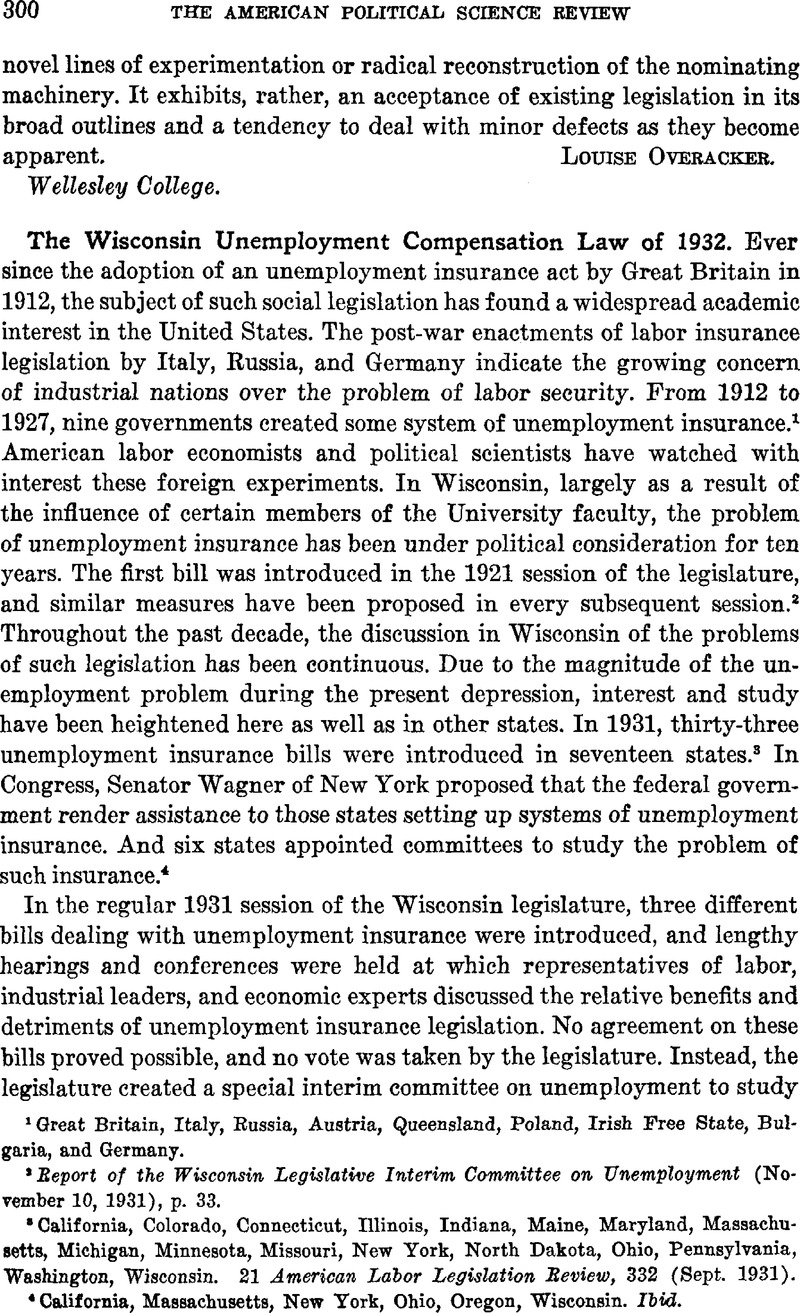Article contents
The Wisconsin Unemployment Compensation Law of 1932
Published online by Cambridge University Press: 02 September 2013
Abstract

- Type
- Legislative Notes and Reviews
- Information
- Copyright
- Copyright © American Political Science Association 1932
References
1 Great Britain, Italy, Russia, Austria, Queensland, Poland, Irish Free State, Bulgaria, and Germany.
2 Report of the Wisconsin Legislative Interim Committee on Unemployment (November 10, 1931), p. 33Google Scholar.
3 California, Colorado, Connecticut, Illinois, Indiana, Maine, Maryland, Massachusetts, Michigan, Minnesota, Missouri, New York, North Dakota, Ohio, Pennsylvania, Washington, Wisconsin. 21 American Labor Legislation Review, 332 (Sept. 1931)Google Scholar.
4 California, Massachusetts, New York, Ohio, Oregon, Wisconsin. Ibid.
5 Joint Resolution 113, 1931 session of Wisconsin legislature.
6 Report of the Wisconsin Legislative Interim Committee on Unemployment, p. 7.
7 Ibid., p. 14.
8 Ibid., p. 15.
9 Ibid., p. 8.
10 Ibid., p. 12.
11 Ibid., pp. 34-35.
12 Ibid., p. 36.
13 Ibid., pp. 37-38.
14 Ibid., p. 38.
15 Ibid., p. 42.
16 The Assembly vote was 63 to 15; the Senate vote, 19 to 9.
17 Laws of Special Session of the 1931 Wisconsin Legislature, ch. 20, sec. 2, 108.01 (1).
18 Ibid., sec. 2, 108.01 (2), (3).
19 Ibid., see. 1 (1), sec. 3 (1).
20 Ibid., sec. 3 (5).
21 Ibid., sec. 2, 108.15 (1).
22 Ibid., sec. 2, 108.15 (4).
23 Ibid., sec. 2, 108.02 (e).
24 Ibid., sec. 2, 108.04 (5).
25 Ibid., sec. 2, 108.04 (8).
26 Ibid., sec. 2, 108.04 (5).
27 Ibid., sec. 2, 108.04 (6).
28 The British unemployment insurance law of 1920 provides for payments on the following Tatio for each employee per week: employer, 8¢; employee, 8¢; the government, 4¢. This amount does not vary with different industries and under changing conditions. Commons and Andrews, , Principles of Labor Legislation (1927), pp. 488–9Google Scholar. The German act of 1927 provides that the employers within each district of the country shall pay 1½ per cent of the wage pay-rolls and the employees 1½ per cent of their wages, until a reserve is established sufficient to care for 600,000 unemployed workers for three months; then the rate for a district may be lowered. 28 Monthly Labor Review, 91 (Jan., 1929)Google Scholar.
29 Laws of Special Session of the 1931 Wisconsin Legislature, ch. 20, sec. 2, 108.18.
30 Ibid., sec. 2, 108.05 (1).
31 Ibid., sec. 2, 108.04 (4).
32 Ibid., sec. 2, 108.05 (3).
33 Ibid., sec. 2, 108.03 (1), 108.06 (3).
34 Ibid., sec. 2, 108.05 (3).
35 Ibid., sec. 2. 108.08 (1), (2).
36 Ibid., sec. 2, 108.09 (1).
37 Ibid., sec. 2, 108.10 (3), (4), (5).
38 Ibid., sec. 2, 108.10 (4).
39 Ibid., see. 2, 108.14 (6).
40 Ibid., sec. 2, 108.19.
41 Ibid., see. 2, 108.25 (1).
42 Ibid., see. 2, 108.26.
43 Chicago Tribune, Feb. 15, 1932; N. Y. Times, Feb. 15, 1932.
44 Laws of Special Session of the 1931 Wisconsin Legislature, ch. 20, sec. 2, 108.11 (1).
45 Adkins v. Children's Hospital, 261 U.S. 525 (1923).
46 Muskrat v. TJ. S., 219 U.S. 346 (1911); Fairchild v. Hughes, 258 U.S. 126 (1922); Massachusetts v. Mellon, 262 U.S. 447 (1923). See also ex parte Young, 209 U.S. 123 (1908), and Tyson v. Banton, 273 U.S. 418 (1927), in which injunctions were employed successfully to test the validity of a statute before its actual enforcement.
47 Note especially O'Gorman and Young v. Hartford Fire Insurance Co., 282 U.S. 251 (1931), and State Board of Tax Commissioners of Indiana v. Jackson, 283 U.S. 527 (1931). In both of these cases, the majority of the court, then consisting of Justices Holmes, Brandeis, Stone, Eoberts, and Hughes, upheld the state statutes; while the minority—Justices Butler, Sutherland, Van Devanter, and McEeynolds—opposed the constitutionality of these acts and in their dissenting opinions quoted a long series of Supreme Court decisions on due process and police power.
48 Coppage v. Kansas, 236 U.S. 1 (1915); Adair v. U. S., 208 U.S. 161 (1907); Lockner v. N.Y., 198 U.S. 45 (1905); Adkins v. Children's Hospital, 261 U.S. 525 (1922); Chas. Wolff Packing Co. v. Court of Industrial Relations of State of Kansas, 262 U.S. 522 (1923), 267 U.S. 552 (1925).
49 Report of the Wisconsin Legislative Interim Committee on Unemployment (1931), pp. 67–68Google Scholar.
50 Adkins v. Children's Hospital, 261 U.S. 525 (1922).
51 Chas. Wolff Packing Co. v. Court of Industrial Relations of State of Kansas, 262 U.S. 522 (1923); Tyson v. Banton, 273 U.S. 418 (1927); Adams v. Tanner, 244 U.S. 590 (1916); Eibnik v. McBride, 277 U.S. 350 (1928).
52 Tyson v. Banton, 273 U.S. 418 (1927); Ribnik v. McBride, 277 U.S. 350 (1928).
53 Pound, E., The Spirit of the Common Law (1921), p. 205Google Scholar.
54 Ibid., pp. 203-5; also “A Theory of Social Interests”, Proceedings of American Sociological Society (1920), XVGoogle Scholar.
55 Lockner v. N.Y., 198 U.S. 45, 75 (1904).
56 Truax v. Corrigan, 257 U.S. 312, 342 (1921).
57 Adkins v. Children's Hospital, 261 XJ.S. 525, 567 (1922).
58 Truax v. Corrigan, 257 U.S. 312, 354-357 (1921). Brandeis, in his decisions, follows this procedure; he collects and presents vast amounts of factual detail concerning the evils that the statute is aimed to remedy and the operation of similar laws elsewhere. A good example of this method can be found in his dissenting opinion in Adams v. Tanner, 244 U.S. 590, 597 (1916).
59 ‘A Theory of Social Interests”, Proceedings of American Sociological Society (1920), XV, 44Google Scholar.
60 N.Y. Central R.R. Co. v. White, 243 U.S. 188 (1927); Mountain Timber Co. v. Washington, 243 U.S. 219 (1917); Arizona Employers' Liability Cases, 250 U.S. 400 (1919).
61 Noble State Bank v. Haskell, 219 U.S. 104 (1910).
- 1
- Cited by




